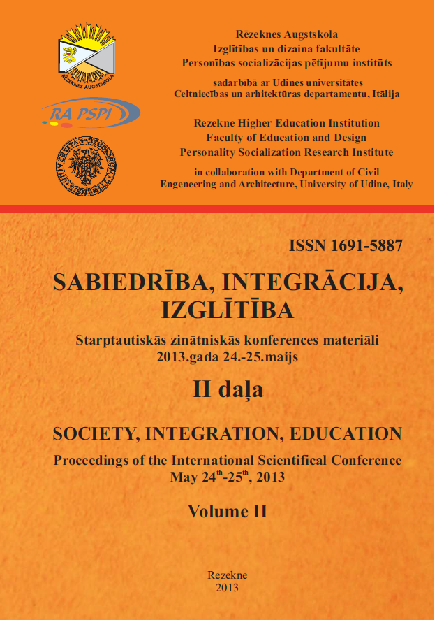Content of psychologycal well – being of Latgale population
DOI:
https://doi.org/10.17770/sie2013vol2.537Keywords:
psychological well – being, Latgale population, positive relationships, autonomy, environmental mastery, personal growth, purpose in life, self-acceptanceAbstract
Psychological well-being affects all areas of a person's life, physical health and social well-being. High psychological well - being make a longer human life and provides continuous personal development and self-improvement. As shown by the results of studies, psychological well-being content varies among different ethnic groups and cultures. Thus, despite the accumulated theoretical and empirical material about the research challenges of wealth, not properly applied research results in other countries to a particular country or region, in this case - Latvia and the Latgale region. Socio-economic development in this region have the lowest rates. These facts raise the question of Latgale adverse socio-economic impact on the psychological well-being of its people. In view of these facts, this study aims are to investigate the population of Latgale psychological well-being lewel and content of this phenomenon.Downloads
References
Barefoot, J.C., Maynard, K.E., Beckham, J.C., Brummett, B.H., Hooker, K. & Siegler, I.C. (1998). Trust, Health, and Longevity. Journal of Behavioral Medicine, 21 (6), 517-526.
Biswas-Diener, R., Vitterso, J., & Diener, E. (2005). Most People are Pretty Happy, but There is Cultural Variation: The Inughuit, The Amish, and The Maasai. The Journal of Happiness Studies, 6(3), 205-226.
Bradburn, N. M. (1969). The structure of Psychological Wellbeing . Aldine Publishing Co.
Erikson E. (1959). Identity and the life cycle. Psychological Issues, 1, 1-171.
Jahoda, M. (1958). Current Concepts of PositiveMental Health. New York: Basic Books.
Ryff, C. D. (1989). Happiness is everything, or is it? Explorations on the meaning of psychological well-being. Journal of Personality and Social Psychology, 57, 1069 – 1081.
Ryff, C.D., Singer, B.H. (2006). Best news yet on the six-factor model of well-being. Social Science Research, 35, 1103–1119.
Ryckman, R.M. (2008). Theories of Personality. Belmint Thomson Higher Education.
Springer, K.W., Hauser, R.M. (2006). An Assessment Of The Construct Validity Of Ryff’s Scales Of Psychological Well-Being: Method, Mode And Measurement Effects, Social Science Research 35, 1080–1102.
Svence, G. (2009). Pozitīvā psiholoģija. Rīga: Apgāds Zvaigzne ABC.
Воронов, В.В., Лавриненко, О.Я. (2011). Доходы населения Латвии: уровень, дифференциация, динамика. Социологические исследования, 9, c. 47.


